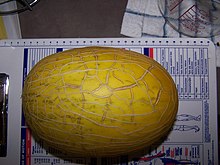Hami melon
| Hami melon | |
|---|---|
 | |
| Genus | Cucumis |
| Species | C. melo |
| Cultivar group | Ameri Group, Inodorus Group, Chandalak Group |
| Hami melon | |
|---|---|
Hanyu Pinyin | Hāmì guā |
| Bopomofo | ㄏㄚ ㄇㄧˋ ㄍㄨㄚ |
| Wade–Giles | Ha1-mi4 kua1 |

The Hami melon is an umbrella term for
Cultivation
The origin of the Hami melon can be traced back to the Han dynasty in China. From 58 to 76 AD, Hami melons were given to Emperor Ming of Han by officials as a rare tribute from the Western Regions and called kùhóng (Chinese: 库洪).[1]
Xinjiang's unique geographical environment (high altitude, large temperature difference between day and night, and sufficient sunshine) has created different varieties of Hami melon, such as the Yellow Honey Hami Melon and the Red Honey Hami Melon.[2] More than 100 cultivated forms and hybrids of the 'Hami' melon have been grown in China.[3]
The Xinjiang Uygur Autonomous Region has different protected areas for the cultivation of Hami melon, among which Yiwu County, Hami, has an area the length of 150 kilometers. The storage method of Hami melon at low temperatures is also unique. Among them, Gold Queen Hami Melons can be stored at 3°C for 18 days and still maintain the original taste.[4]
References
- OCLC 49274563.
- ^ "哈密瓜--新疆美食--新疆地情网". www.xjtonglan.com. Retrieved 2022-12-02.
- ISBN 978-94-007-1763-3.
- S2CID 91318912.
- Anderson, Eugene N. (1990). The Food of China. New Haven: ISBN 978-0300047394.
- "Foodista: Hami Melon". Retrieved 13 August 2013.
- China Culture
- "Melons: Cantaloupe, Muskmelon, Honeydew, Crenshaw, Casaba, etc". Retrieved 19 August 2013.

